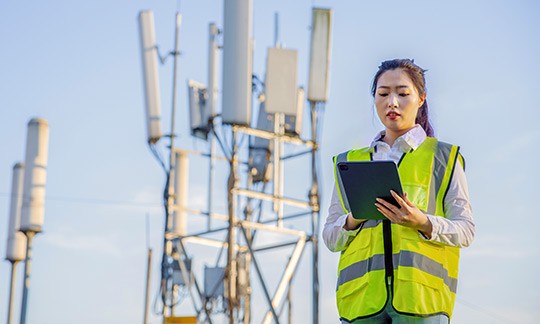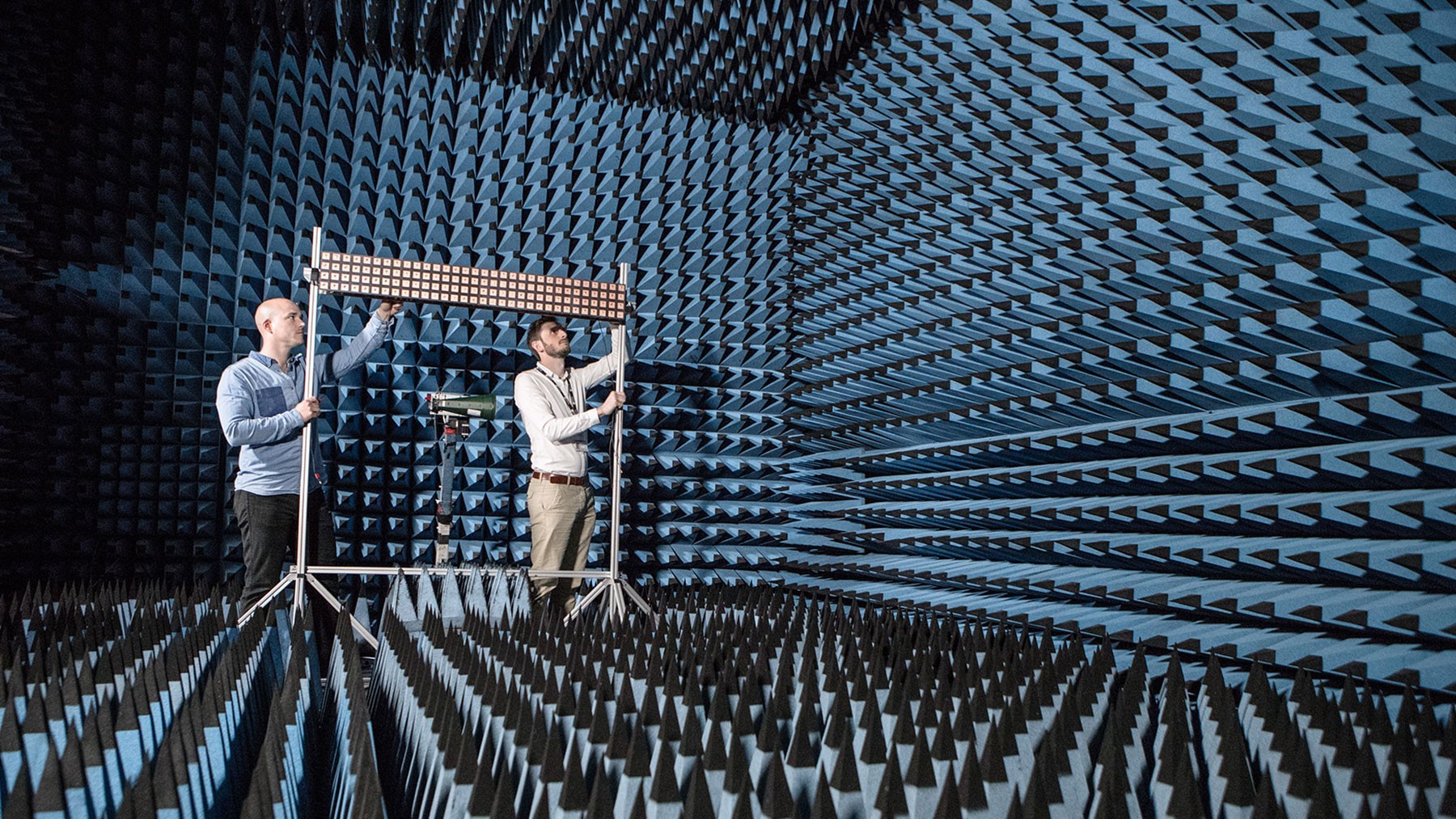
What is 5G mmWave?
BUSINESS INSIGHT
5G AND 6G TECHNOLOGY | 6 MINUTE READ
5G mmWave technology enables high-bandwidth, low latency communications. Learn about the benefits & applications of 5G mmWave at ni.com.
5G mmWave refers to fifth-generation wireless technology utilizing signals between 24 GHz and 100 GHz on the radio frequency spectrum. Using millimeter waves (mmWave) enables high-bandwidth, low-latency data transmission at speeds that exceed 1 Gbps and approach 10 Gbps under ideal conditions.
It’s important to understand that 5G and mmWave are two technologies working in concert to support applications requiring high data rates and minimal latency. These applications include mobile broadband, automotive communication, and the Internet of Things (IoT). While mmWave has traditionally been used in satellite and radar communications, bringing it to 5G mobile networks marks a significant improvement from earlier standards that primarily operated on sub-6 GHz frequencies.
What is mmWave Technology?
mmWave technology leverages high frequencies capable of carrying significant amounts of data. This capacity comes with a tradeoff: millimeter waves offer limited penetration through solid objects, so they operate over short distances. This characteristic necessitates innovative network designs, including the deployment of mmWave antennas in a configuration known as small cells. These small cells are pivotal in managing the data load effectively, ensuring consistent coverage and alleviating network congestion.

Key Applications and Benefits of 5G mmWave
The application of 5G mmWave technology has the potential to fundamentally improve wireless communication across various sectors, with benefits for the following applications:
- High-Definition Content Streaming—5G mmWave technology can support seamless streaming of 4K and 8K videos and enhanced gaming with minimal lag. The benefits of 5G mmWave for these applications are manifold: it ensures smoother playback, quicker load times, and a more reliable connection, even in densely populated areas. This improved user experience makes high-quality content more accessible and enjoyable in real-time.
- Virtual Reality (VR) and Augmented Reality (AR)—5G mmWave technology transforms VR and AR through the rapid and reliable transmission of data. Key applications include VR/AR gaming, real-time interactive AR experiences, and remote assistance and training. The benefits of 5G mmWave for virtual and augmented reality are substantial—it enables more responsive and fluid interactions, reduces lag, and supports higher-resolution graphics, making applications more immersive and lifelike. This increased fidelity creates new possibilities for VR and AR in various fields such as entertainment, education, and professional services.
- IoT Devices—Ultra-fast data speeds and low latency significantly enhance the capabilities of Internet-of-Things devices. Key applications include smart city infrastructure and smart home technology. The benefits of 5G mmWave for the IoT are numerous; it allows for real-time data processing, supports a vast number of connected devices, and improves overall network reliability.
- Industrial Automation—5G mmWave technology enables real-time monitoring, precise control of machinery, and rapid data transfer across manufacturing processes. These capabilities can result in improved operational efficiency, reduced downtime, and higher productivity. The robust connectivity provided by 5G mmWave ensures seamless communication between devices and systems, facilitating smarter factories and more responsive supply chains.
- Healthcare—5G mmWave supports cutting-edge telemedicine, real-time patient monitoring, and rapid medical data transmission. This advancement facilitates quicker diagnostics, more precise treatments, and continuous care, enhancing patient outcomes and healthcare efficiency. The robust connectivity ensures that medical services are readily available, significantly improving the quality and accessibility of healthcare.
- Emergency Response Systems—5G mmWave technology can strengthen emergency response systems by providing high-speed, stable wireless communications that are crucial during critical situations. This technology enables seamless, real-time data transmission, which is vital for coordinating swift and effective emergency responses. For instance, 5G mmWave facilitates the instant sharing of high-resolution video and images from an emergency site to a central command center, allowing for immediate assessment and strategic decision-making. It also supports the deployment of advanced applications such as remote medical diagnostics and drone-based surveillance, ensuring that emergency teams can make informed decisions quickly, potentially saving lives and mitigating the impact of disasters.
5G mmWave Network Capacity
A major benefit of 5G mmWave technology is the vast amount of open spectrum it offers, allowing the support of a massive number of devices simultaneously. In today’s society the number of connected devices per household is growing exponentially—from smart home devices to IoT sensors. This abundance of available spectrum ensures that the network can handle large volumes of data. This capability is vital for the development of smart cities and connected communities, where hundreds of interconnected devices require reliable and uninterrupted connectivity.
Challenges and Future Prospects
While 5G mmWave offers considerable advantages, its deployment faces challenges such as signal attenuation, limited range, and the necessity for line-of-sight connectivity. Additionally, the need for new, specialized infrastructure specific to mmWave, which often does not exist in current cellular networks, presents a significant hurdle. These issues require innovative technological solutions like advanced beamforming, phased arrays, network densification, and the development of dedicated infrastructure to ensure effective coverage and service reliability.
How NI Supports 5G mmWave Technology
5G mmWave is reshaping wireless communication with its unprecedented speed and capacity, supporting a new era of digital innovation. It’s an essential component to bringing next-generation technology to the real world. NI hardware and software is at the forefront of 5G mmWave engineering and testing. With an established presence in the automotive, semiconductor, and aerospace sectors, NI is uniquely positioned to bring this promising technology into more widespread use.
NI's comprehensive suite of solutions helps contribute to advancing 5G mmWave technology. Over-the-air (OTA) validation tests are essential for 5G mmWave technology because they accurately assess the performance of beamforming MIMO antenna arrays in real-world conditions, ensuring reliable high-frequency signal transmission. Traditional conducted tests become impractical due to the spatial characteristics of the waveforms and the number of antennas involved in beamforming for MIMO antenna arrays.
NI's OTA Validation Reference Architecture integrates the PXIe-5842 with a 54 GHz frequency extension. It provides a streamlined and effective solution for conducting over-the-air tests in high-frequency environments. This cohesive hardware and software set minimizes path loss through a remote measurement module architecture positioned near the test chamber. This integration ensures efficient and accurate testing, essential for developing reliable 5G technologies.
In addition, our versatile PXI Vector Signal Transceiver (VST) can be seamlessly integrated into Semiconductor Test Systems (STS) for high-volume Radio Frequency Front End (RFFE) production testing, enhancing the efficiency and scalability of production processes. NI's modular instrumentation and open software technologies also cater to the evolving demands of radar and electronic warfare (EW) systems. The ability to deliver adaptable threat emulation, perform real-time signal monitoring, and conduct wideband RF record and playback on a common modular platform demonstrates NI's commitment to providing cutting-edge solutions.
Through these advanced tools and technologies, NI empowers engineers to push the boundaries of 5G mmWave innovation, ensuring robust performance and accelerating the deployment of next-generation wireless communication systems.



